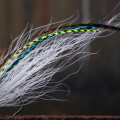Ask MidCurrent: How Do I Get My Sinking Tip to the Surface to Re-Cast?

Roll-casting your sinking tip to the surface helps break the water’s hold on the front of your line. Photo: Clare Monahan
Question: I’ve been fishing a sinking-tip line and big streamers this spring, and at the end of each retrieve, I struggle to get the heavy tip out of the water to re-cast. What’s the best way to do this?
—Geoff from Little Rock, AR (via the Ask MidCurrent form)
Answer: Fishing with sinking-tip lines allows you to target fish that hold deep in heavy currents, but this approach often introduces a significant challenge: lifting the line out of the water efficiently and safely. A standard overhead pickup—a swift lift and backcast—may work fine with floating lines. However, with sinking-tips or full-sinking lines and weighted streamers, this method becomes a recipe for frustration. That’s where the roll-cast pickup becomes your best friend. It’s a smooth, powerful, and safer way to bring your fly into the air and get it back into the strike zone with precision.
Unlike floating lines, sinking setups act like anchors. This creates two major problems: the water’s grip on the line makes it physically difficult to lift, and the sunken fly can become snagged on underwater rocks or sticks. An aggressive overhead lift often yanks the fly out in an uncontrolled arc, risking injury or tangling. If you try to muscle the line out of the water, you could end up straining your casting arm or launching your fly and leader into a tree or bush behind you.
The Roll-Cast Pickup
The roll-cast pickup offers a simple way to get the line to the surface without resistance. It starts with a basic roll cast, but in this case, it’s not used to present the fly. Instead, the roll cast serves to lift the sunken line, reposition the fly, and prepare for an immediate overhead backcast.
Imagine you’re standing in waist-deep water, your sinking-tip line is down around your knees, and a weighted streamer is fluttering near the bottom. Instead of yanking the rod upward, you slowly lift the rod tip, allowing the line to come toward you. You allow the line below your rod tip to form a D-loop and sweep forward in a roll-cast motion. As the line unrolls, it pulls the tip of the line to or near the surface —ready for a clean pickup into a full overhead cast. In some cases, if the tip of the line is really deep, you may need to make make two roll casts to get it to the surface.
Why It Works
The roll-cast pickup works so well because it breaks the water’s adhesion incrementally. Rather than attempting to lift the entire water-logged system in one violent motion, it brings it to the surface progressively. The result is a far more energy-efficient cast that doesn’t strain your arm or put stress on your tippet.
Furthermore, the roll-cast pickup keeps the fly closer to the water during the lift, reducing the likelihood of a high, snapping trajectory that could send a heavy fly hurtling toward your face. It’s not just more efficient; it’s also safer.
While this technique is simple in principle, execution matters. Slow your tempo: the motion should feel deliberate and smooth rather than rushed or forceful. And most importantly, practice the transition from roll-cast to overhead backcast, so it becomes a single, fluid motion.
If you’re an angler who regularly fishes deep, the roll-cast pickup is a valuable skill. It’s more than just a workaround for tricky casting situations; it’s also a technique that offers control, efficiency, and safety. With a little practice, you’ll find your casts becoming more confident, your presentations more precise, and your time on the water far more productive.











